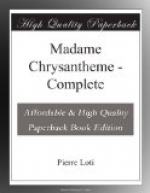About nine o’clock, with a silken rustling, arrive the three geishas in vogue in Nagasaki: Mesdemoiselles Purete, Orange, and Printemps, whom I have hired at four dollars each—an enormous price in this country.
These three geishas are indeed the very same little creatures I heard singing on the rainy day of my arrival, through the thin panelling of the Garden of Flowers. But as I have now become thoroughly Japanized, today they appear to me more diminutive, less outlandish, and in no way mysterious. I treat them rather as dancers that I have hired, and the idea that I ever had thought of marrying one of them now makes me shrug my shoulders—as it formerly made M. Kangourou.
The excessive heat caused by the respiration of the mousmes and the burning lamps, brings out the perfume of the lotus, which fills the heavy-laden atmosphere; and the scent of camellia-oil, which the ladies use in profusion to make their hair glisten, is also strong in the room.
Mademoiselle Orange, the youngest geisha, tiny and dainty, her lips outlined with gilt paint, executes some delightful steps, donning the most extraordinary wigs and masks of wood or cardboard. She has masks imitating old, noble ladies which are valuable works of art, signed by well-known artists. She has also magnificent long robes, fashioned in the old style, with trains trimmed at the bottom with thick pads, in order to give to the movements of the costume something rigid and unnatural which, however, is becoming.
Now the soft balmy breezes blow through the room, from one veranda to the other, making the flames of the lamps flicker. They scatter the lotus flowers faded by the artificial heat, which, falling in pieces from every vase, sprinkle the guests with their pollen and large pink petals, looking like bits of broken, opal-colored glass.
The sensational piece, reserved for the end, is a trio on the ‘chamecen’, long and monotonous, that the geishas perform as a rapid pizzicato on the highest strings, very sharply struck. It sounds like the very quintessence, the paraphrase, the exasperation, if I may so call it, of the eternal buzz of insects, which issues from the trees, old roofs, old walls, from everything in fact, and which is the foundation of all Japanese sounds.
Half-past ten! The programme has been carried out, and the reception is over. A last general tap! tap! tap! the little pipes are stowed away in their chased sheaths, tied up in the sashes, and the mousmes rise to depart.
They light, at the end of short sticks, a quantity of red, gray, or blue lanterns, and after a series of endless bows and curtseys, the guests disperse in the darkness of the lanes and trees.
We also go down to the town, Yves, Chrysantheme, Oyouki and I—in order to conduct my mother-in-law, sisters-in-law, and my youthful aunt, Madame Nenufar, to their house.
We wish to take one last stroll together in our old familiar pleasure-haunts, to drink one more iced sherbet at the house of the Indescribable Butterflies, buy one more lantern at Madame Tres-Propre’s, and eat some parting waffles at Madame L’Heure’s!




